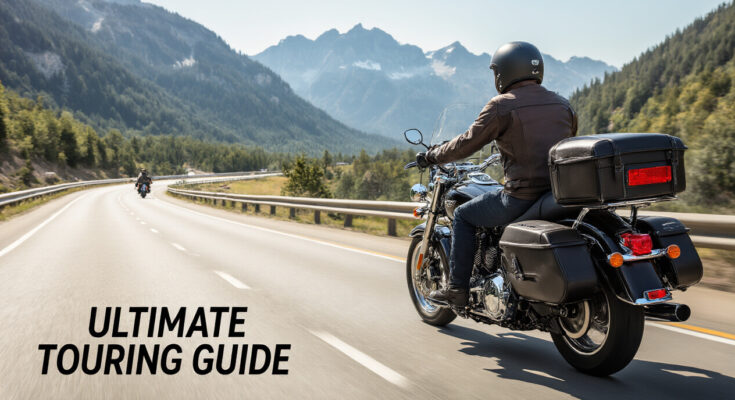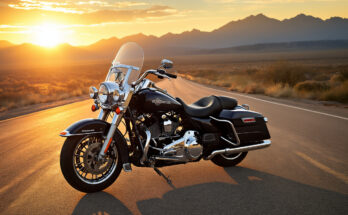Ever wondered why some riders can cruise for 500 miles while others are begging for mercy after 100? It’s not willpower – it’s the bike, buddy.
The difference between a good touring motorcycle and a great one is like choosing between coach and first class for a cross-country flight. Yeah, both get you there, but one leaves you needing a chiropractor.
In this guide, we’ll break down everything about touring motorcycles in USA that the dealerships won’t tell you – from which bikes actually deliver all-day comfort to the maintenance secrets that’ll save your trip (and wallet).
Whether you’re planning your first multi-state adventure or upgrading your current ride, what you learn here might completely change which bike you’ve got your eye on.
Choosing the Perfect Touring Motorcycle
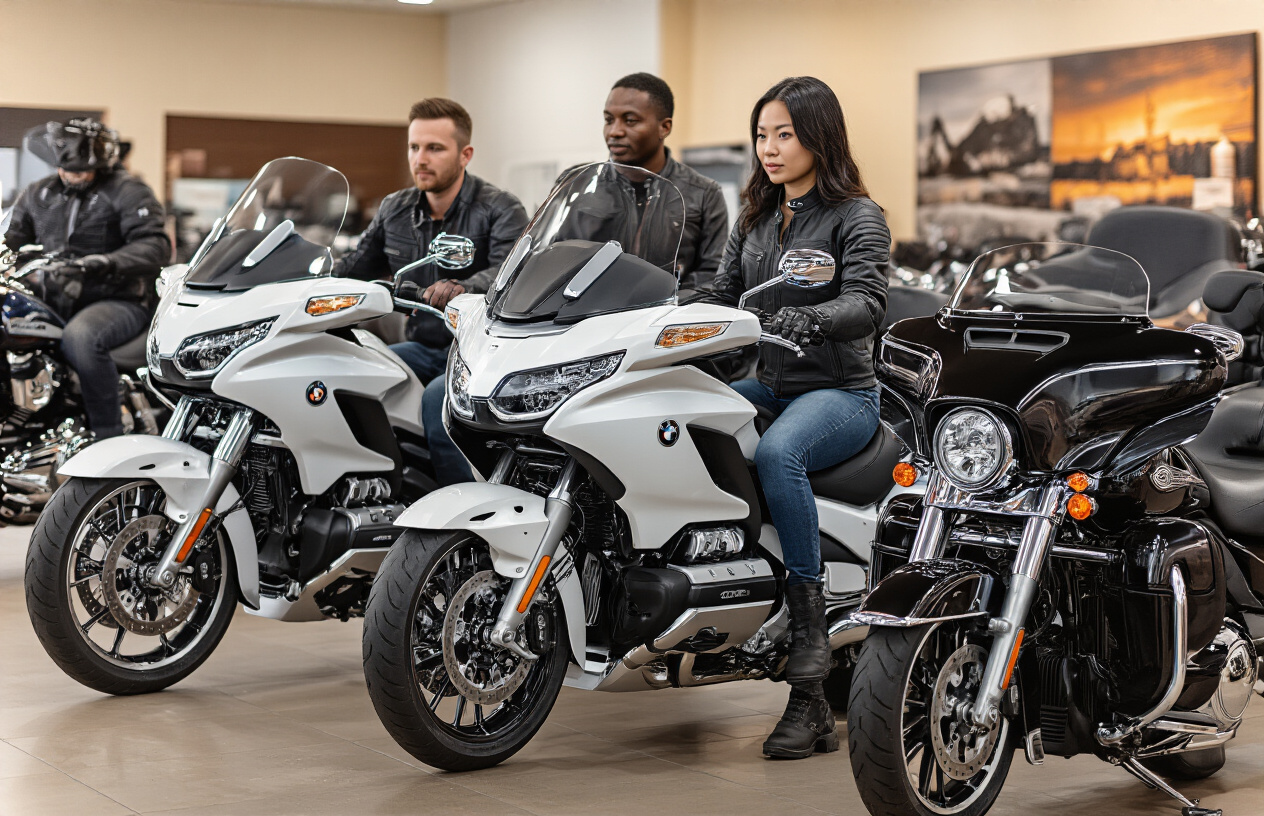
Understanding Different Types of Touring Bikes
Touring motorcycles aren’t one-size-fits-all. Think of them as tools – you need the right one for your specific journey.
Full-dress tourers like the Honda Gold Wing and Harley-Davidson Ultra Limited come loaded with everything but the kitchen sink. Windshields, fairings, heated seats, ridiculous storage space, and entertainment systems that rival your living room. They’re built for those cross-country trips where comfort is non-negotiable.
Sport-tourers (think BMW R1250RT or Kawasaki Concours) split the difference between speed demons and comfort cruisers. They pack enough storage and wind protection for long hauls but still corner like they mean business. Perfect for riders who get bored on straight highways.
Adventure tourers like the BMW GS series or Triumph Tiger are the Swiss Army knives of the motorcycle world. They’ll take you from smooth asphalt to dirt roads without breaking a sweat. A bit taller, rugged suspension, and that “I could cross a desert if I wanted” attitude.
Bagger-style cruisers – those Indian Chieftains and Harley Street Glides – blend American cruiser vibes with practical touring capabilities. Lower seat heights, relaxed riding positions, and enough chrome to blind oncoming traffic.
Key Features for Long-Distance Comfort
Riding for 8+ hours is a whole different ballgame than zipping to the coffee shop. The comfort features that seemed like luxuries become necessities real quick.
Wind protection makes or breaks touring. A good windscreen diverts air around you instead of pummeling your chest for hours. Adjustable is better – what works at 65mph might be a noisy disaster at 75mph.
Ergonomics matter more than anything. Your seat needs to support your tailbone properly – not just feel good during a 10-minute test ride. Handlebar position should let your arms relax, not stretch like you’re doing yoga. Footpeg placement determines whether your knees scream after an hour or stay happy all day.
Modern tourers come with creature comforts that sound excessive until you’ve needed them: heated grips for those chilly mountain passes, cruise control to give your wrist a break, adjustable suspension that adapts to changing loads, and infotainment systems with GPS that save you from squinting at your phone.
Weight and Balance Considerations
Touring bikes are beasts – often tipping the scales at 800+ pounds fully loaded. That weight brings stability on highways but becomes a handful at parking lot speeds.
Balance matters more than raw weight. A well-balanced 900-pound tourer can feel lighter than a poorly designed 700-pound bike. Test how the bike feels when you’re walking it around, especially when backing into parking spots.
Center of gravity determines how a bike handles. Lower is generally better for touring – it keeps the bike planted and less susceptible to crosswinds. But too low, and you sacrifice ground clearance.
Weight distribution between front and rear wheels affects everything from steering effort to stability. The best touring bikes maintain proper distribution even when loaded with passengers and luggage.
Don’t forget to consider your own size in this equation. A bike that feels perfectly balanced for a 6’2″ rider might be unwieldy for someone 5’5″.
Budget Options vs. Premium Models
The price gap between entry-level and premium touring motorcycles is wider than the Grand Canyon. But the question isn’t just what you can afford – it’s what value you’re getting.
Premium models like the BMW K1600 GTL or Harley CVO Limited (easily $30,000+) offer next-level refinement: smoother engines, sophisticated electronics packages, premium materials, and that “everything just works” feeling. The suspension components alone justify thousands in price difference when you’re covering 500 miles in a day.
Mid-range options like Yamaha FJR1300 or Indian Challenger deliver 85% of the premium experience at 65% of the cost. You’ll sacrifice some features and refinement, but the core touring capabilities remain solid.
Budget-friendly choices include used Japanese tourers (older Gold Wings hold up remarkably well) or converting standard bikes with aftermarket windscreens and luggage. Kawasaki Versys and Suzuki V-Strom models make excellent platforms for budget touring setups.
Remember that the true cost includes maintenance, fuel efficiency, and reliability. That bargain-priced European tourer might cost more in the long run than the pricier Japanese bike with bulletproof reliability.
Essential Comfort Features for Cross-Country Rides
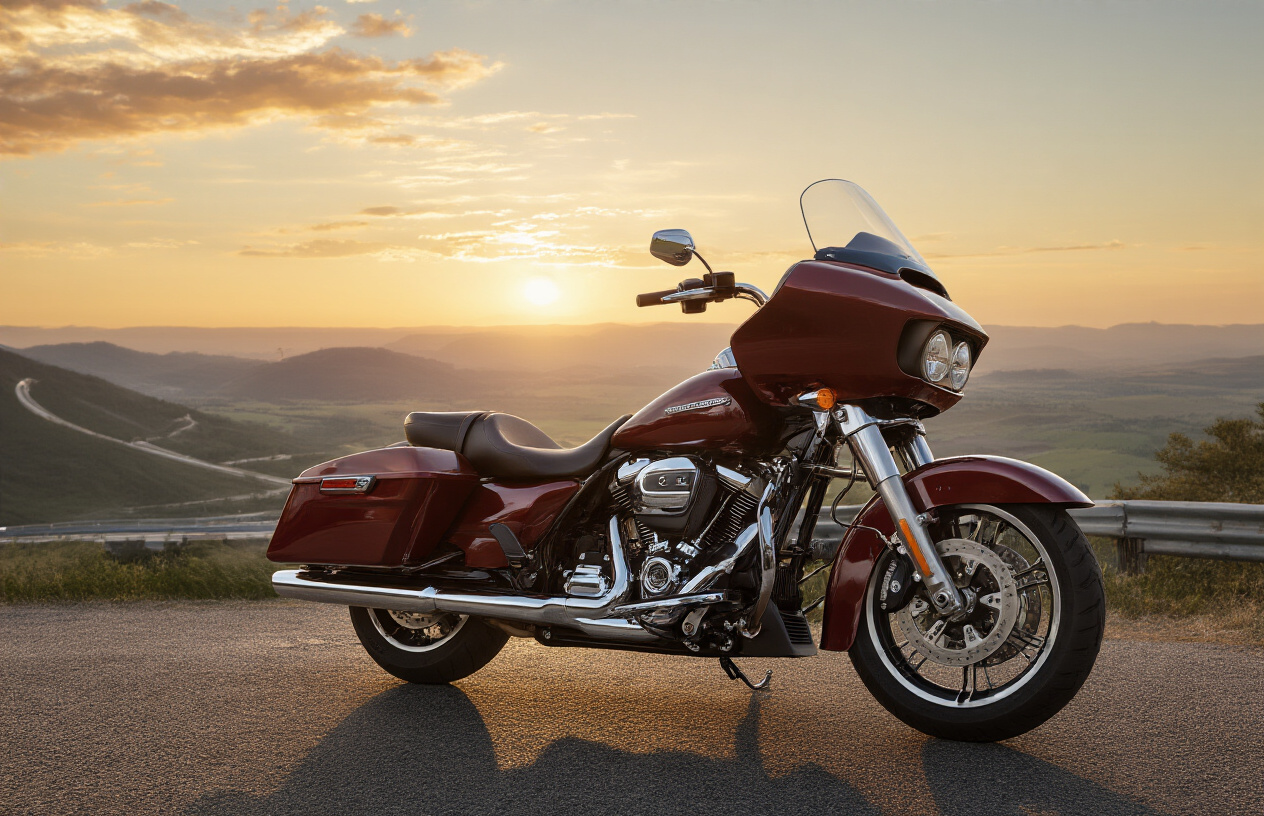
A. Ergonomics and Rider Position
Ever ridden 300 miles only to wake up feeling like you’ve been hit by a truck? That’s bad ergonomics talking. Touring bikes worth their salt position your body in a neutral stance—slightly forward lean, knees at a comfortable 90-degree angle, and arms relaxed.
The best touring motorcycles like the Honda Gold Wing and BMW K1600 GTL come with adjustable handlebars and footpegs. That’s not just fancy marketing—it’s essential when you’re spending 8+ hours in the saddle. Many riders overlook this until they’re 500 miles into a trip with numb hands and locked knees.
B. Windshield and Weather Protection
Nothing ruins a scenic ride faster than being blasted by wind for hours. A proper windshield should direct air over your helmet, not slam it into your chest.
Adjustable windshields are game-changers. Too hot? Lower it for some cooling airflow. Rain starting? Crank it up for maximum protection. Brands like Harley-Davidson and Indian offer electronically adjustable windshields—totally worth the extra cash.
Don’t forget about hand guards and lower fairings. They seem insignificant until you ride through a 55-degree mountain pass or sudden downpour.
C. Seat Comfort and Customization Options
The stock seat on most bikes is a compromise. Even premium touring motorcycles benefit from upgrades.
What makes a good touring seat? Dense foam that doesn’t compress over long distances, a wide platform to distribute weight, and a shape that prevents sliding forward during braking.
Aftermarket options from Corbin, Saddlemen, and Russell Day-Long provide custom-fitted alternatives based on your riding position and body type. Many include gel inserts or heating elements for those chilly morning departures.
D. Passenger Accommodations
Your passenger deserves comfort too. Look for:
- Dedicated grab rails positioned naturally
- Separate backrest with adequate lumbar support
- Footpegs aligned with their seating position
- Enough width to prevent the “perching” feeling
The Yamaha Venture and Indian Roadmaster excel here with heated passenger seats and backrests that can be adjusted independently. Smart design prevents that awkward helmet-bumping situation during braking.
E. Luggage Systems and Storage Solutions
The difference between stuffing everything in a backpack and having a proper luggage system is night and day.
Hard cases offer security and weather protection but add width. Soft bags provide flexibility but less protection. The best touring setups feature:
- Integrated side cases with quick-release mechanisms
- Top case large enough for two full-face helmets
- Tank bag for quick-access items
- Smaller compartments for electronics, documents, and sunglasses
Weight distribution matters enormously. Overload one side, and your bike handles like it’s drunk. The best systems let you balance weight low and centered.
Mastering Motorcycle Maintenance on the Road
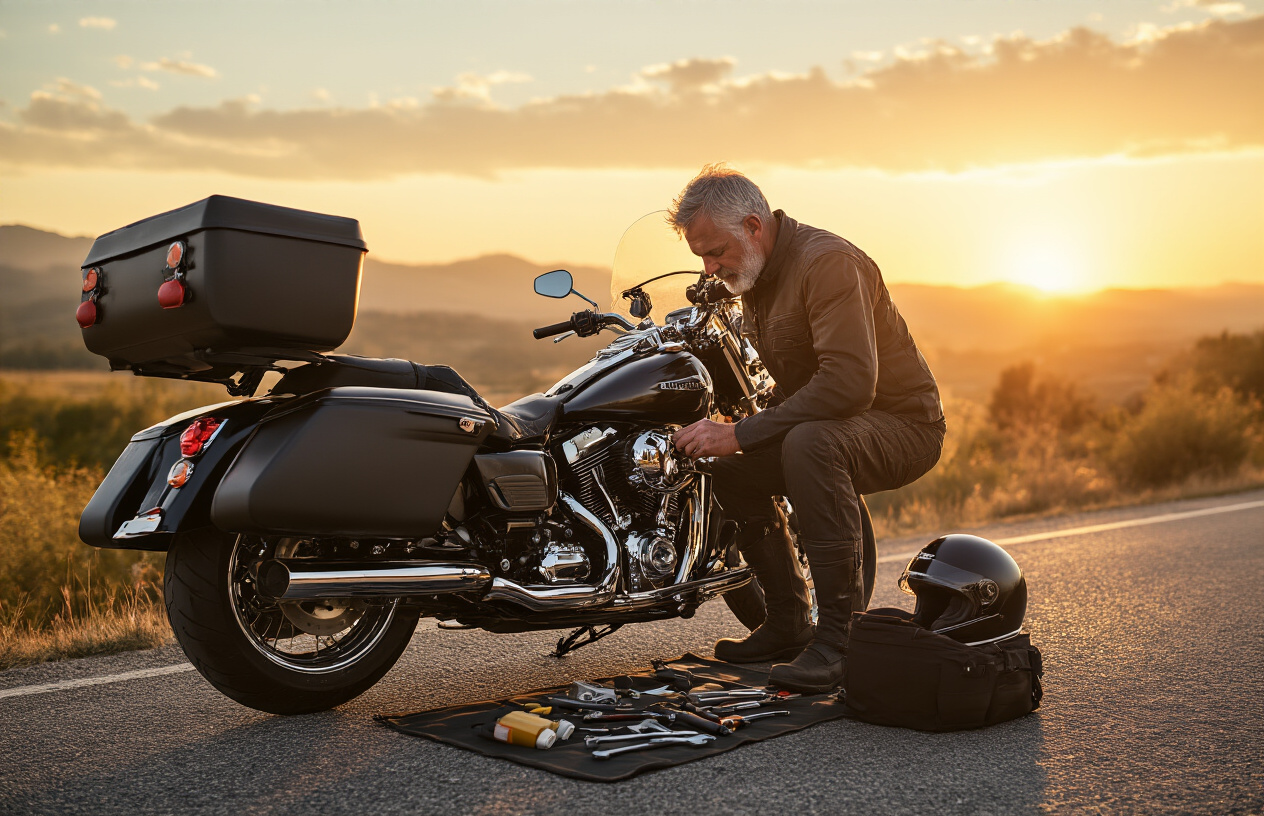
Pre-Trip Inspection Checklist
Nothing kills a road trip faster than a preventable breakdown. Trust me, I’ve been there – stranded on a desert highway with a bike that wouldn’t start because I skipped checking my battery terminals.
Before hitting the road, run through these essentials:
- Tires: Check pressure cold, inspect for wear, and look for embedded objects
- Fluids: Oil, coolant, brake fluid, and fork oil levels all good?
- Chain: Proper tension and lubrication will save your sprockets
- Lights: All working? Carry spare bulbs just in case
- Controls: Throttle, clutch, and brake levers operating smoothly?
- Battery: Clean terminals, proper charge, and secure connections
- Fasteners: Any loose bolts, especially on handlebars and foot pegs?
Essential Tools to Carry
Your toolkit doesn’t need to rival a mechanic’s garage, but skimp on basics and you’ll regret it.
Must-haves for touring:
- Multi-tool with pliers and screwdrivers
- Tire repair kit and compact air compressor
- Adjustable wrench and socket set with common sizes
- Electrical tape and zip ties (magic fixers for so many issues)
- Headlamp (ever tried holding a flashlight while fixing something?)
- JB Weld or similar epoxy
- Chain lube and brake cleaner
Common Roadside Repairs
Flat tires happen. Batteries die. Chains break. Knowing how to handle these saves your trip.
Most common fixes you should master:
- Tire repair: Plug kits are your friend, but practice at home first
- Jump starting: Carry compact jumper cables or a battery pack
- Chain adjustment: Loose chains damage sprockets, tight ones can snap
- Electrical troubleshooting: Fuses blow, connectors vibrate loose
- Clutch cable replacement: Carry a spare and know how to install it
Finding Reliable Service Centers Across America
When DIY won’t cut it, you need professional help. The best shops aren’t always the biggest.
How to find good help on the road:
- Join rider forums and ask for recommendations before your trip
- Save the “Motorcycle Shop Map” offline on your phone
- Talk to local riders at gas stations and diners – they know who’s trustworthy
- Avoid chain stores for specialized work
- Dealerships are reliable but often booked solid in summer months
- Keep service records on your phone to show mechanics what’s been done
Small-town mechanics often provide better service than big-city shops. That guy in Montana who fixed my fuel pump? Still sends me Christmas cards.
Maximizing Performance for Different Terrains
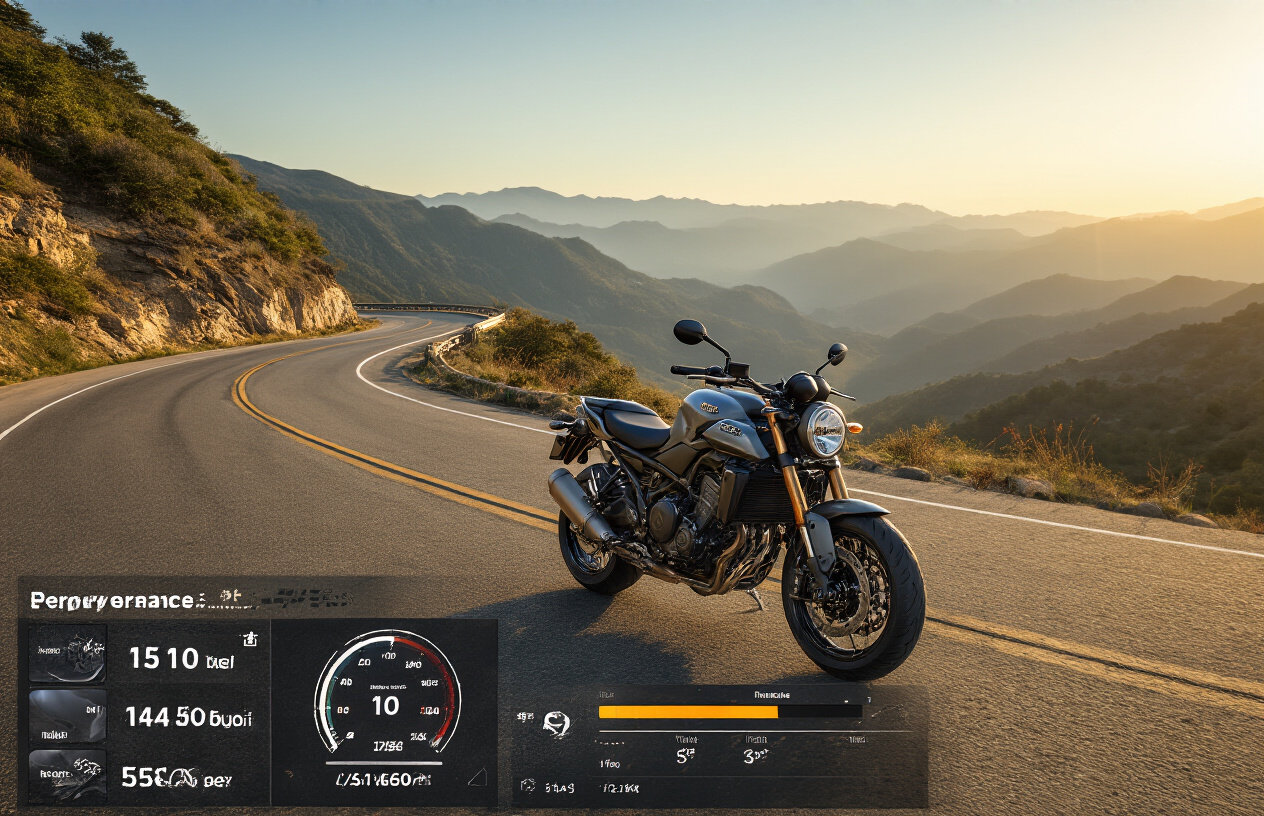
Engine and Power Delivery for Highway Cruising
You’re cruising down Route 66, wind in your face, endless road ahead. What makes that experience perfect? The right power delivery.
Touring bikes shine on highways with their larger displacement engines (typically 1000cc+) that deliver smooth, consistent power. Don’t twist that throttle too aggressively—a steady hand keeps the ride comfortable for hours.
The sweet spot? Maintaining 3000-4000 RPM on most touring models. This range gives you enough torque for effortless passing without straining the engine or burning excessive fuel.
Activate cruise control on those long stretches. It’s not just about comfort—it keeps engine performance optimal and prevents the subtle throttle variations that waste gas.
Handling Mountain Roads and Twisties
Mountain roads demand a different approach. Drop a gear lower than you normally would—you’ll want that extra torque when exiting corners.
Preload adjustments make all the difference here. Tighten up your suspension before hitting those curves. A slightly firmer setup improves handling without sacrificing too much comfort.
Weight distribution matters more than you think. Lean forward slightly on uphill twisties to put more weight on the front wheel for better grip and steering response.
Brake early, accelerate smoothly. Touring bikes aren’t sport bikes—respect their weight and enjoy the rhythm of the road rather than fighting it.
Adjusting for Different Weather Conditions
Rain turns your touring experience upside down. Reduce tire pressure by 2-3 PSI for better grip on wet surfaces.
Cold weather thickens oil and stiffens rubber. Give your bike extra warm-up time—about 5 minutes of gentle riding before pushing it.
Heat is the silent performance killer. When temperatures climb above 90°F, your engine runs hotter and loses efficiency. Take more frequent breaks and avoid peak afternoon heat.
Crosswinds are the sneaky challenge no one talks about. Lower your body profile and maintain a firm but relaxed grip on the handlebars.
Fuel Efficiency Strategies
Proper gear selection might save you 10-15% in fuel. Upshift early but not so early that the engine lugs.
Aerodynamics play a huge role. A windscreen that’s too short forces you to fight the wind, wasting energy and fuel. Adjust it to direct air just over your helmet.
Pack smart, ride light. Every 20 pounds of unnecessary gear costs you roughly 1% in fuel efficiency.
The biggest fuel waster? Rapid acceleration. A smooth, progressive throttle hand will stretch your tank range by 30+ miles on many touring bikes.
Planning the Ultimate USA Motorcycle Tour
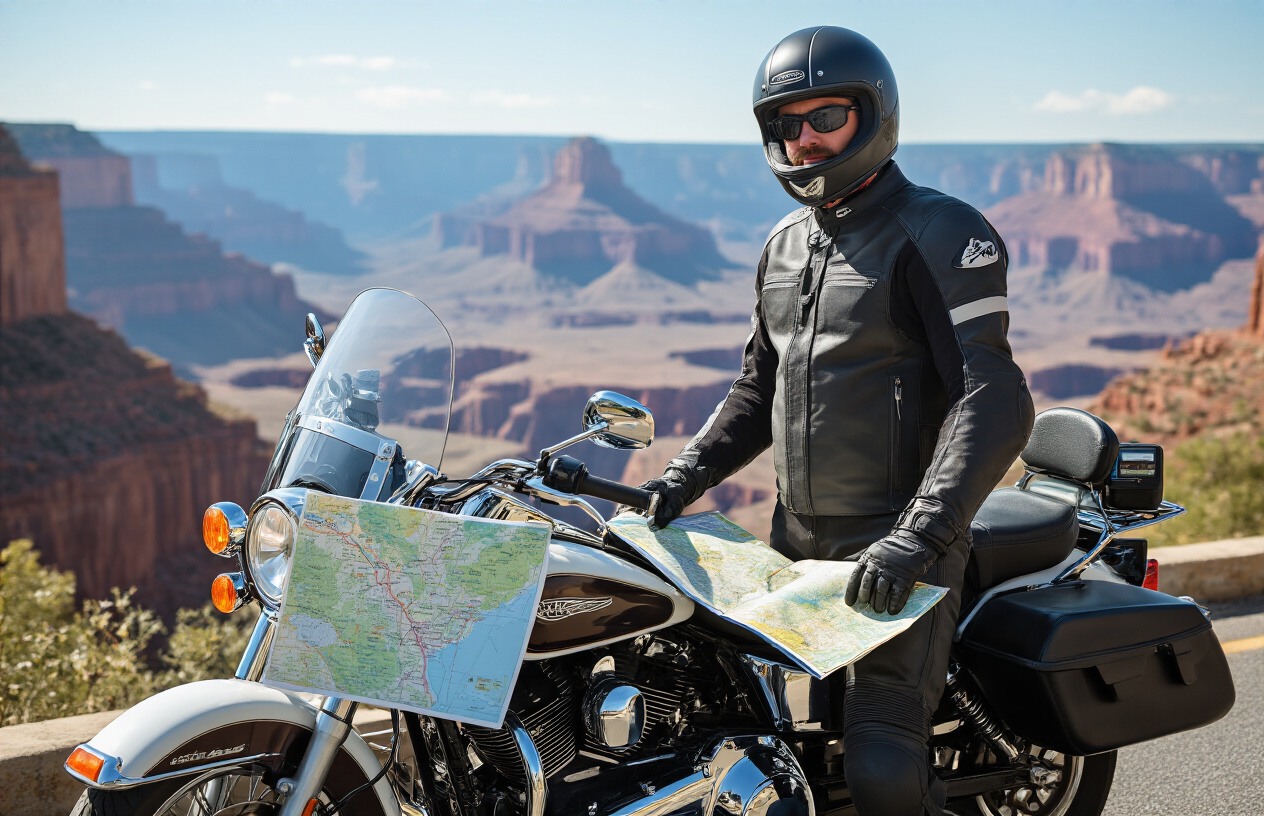
Iconic Routes and Destinations
Ever dreamed of feeling the wind rush past as you cruise through America’s most breathtaking landscapes? You’re not alone. The USA is a motorcycle touring paradise with routes that’ll make your heart race faster than your engine.
The Pacific Coast Highway in California is simply jaw-dropping. Ocean on one side, mountains on the other – it’s 656 miles of pure riding bliss from San Francisco to San Diego.
Route 66 is the granddaddy of American road trips. This historic highway stretches 2,448 miles from Chicago to Santa Monica, passing through the heartland of America with quirky roadside attractions that’ll have you stopping every few miles.
Want something more rugged? The Blue Ridge Parkway winds 469 miles through the Appalachian Highlands, offering riders tight curves and elevation changes that’ll test your skills while rewarding you with misty mountain views that’ll burn into your memory forever.
For desert lovers, nothing beats Utah’s Monument Valley. Those massive sandstone buttes rising from the desert floor create an other-worldly riding experience you can’t find anywhere else.
Seasonal Considerations
Timing is everything in motorcycle touring. Get it wrong and you’ll be riding through a blizzard or melting in 110-degree heat.
Summer (June-August) offers the most daylight hours and access to high-elevation routes like Colorado’s Million Dollar Highway, but you’ll battle tourist traffic and scorching temperatures in places like Death Valley (where the mercury regularly hits 120°F).
Spring and fall are the sweet spots for most regions. The temperatures are kinder to riders, the tourist crowds thinner, and in fall, the changing colors in places like New England create a backdrop that’ll have you stopping for photos every five minutes.
Winter riding isn’t impossible, but it limits you to southern routes. The Florida Keys and Texas Hill Country stay rider-friendly while the rest of the country freezes.
| Season | Best Regions | Challenges |
|---|---|---|
| Spring | Southwest, Southeast, California | Rain in some areas, unpredictable weather |
| Summer | Pacific Northwest, Northern Rockies, Alaska | Heat, crowds, higher prices |
| Fall | New England, Appalachians, Midwest | Shorter days, cooler mornings |
| Winter | Florida, Texas, Arizona, Southern California | Limited daylight, closed mountain passes |
Accommodation Options for Motorcycle Travelers
Where you rest your head matters almost as much as the ride itself. Your options run the gamut from luxury to roughing it.
Motorcycle-friendly hotels are popping up everywhere. Best Western and some independent hotels even offer “Ride Rewards” programs with covered parking, rags for bike cleaning, and sometimes laundry facilities for your riding gear.
Camping puts you right in the heart of nature and saves serious cash. Many riders swear by the KOA (Kampgrounds of America) network – they’re clean, affordable, and often have cabin options if you’re not feeling the tent life after a long day in the saddle.
Airbnbs and vacation rentals give you more space to spread out gear and often provide secure parking that hotels sometimes can’t. Plus, having a kitchen means not eating restaurant food for every meal.
For the social butterflies, motorcycle-specific hostels like the Horizons Unlimited network connect you with fellow riders and often feature shared tools and maintenance areas.
Navigation Tools and Technologies
Getting lost used to be part of the adventure. Now it’s optional.
Dedicated motorcycle GPS units from Garmin and TomTom offer glove-friendly screens, weather resistance, and motorcycle-specific routing that avoids dirt roads unless you want them.
Smartphone apps have revolutionized motorcycle navigation. Rever, Calimoto, and Butler Maps don’t just get you from A to B – they find the twistiest, most scenic routes between points and let you download maps for those no-signal zones.
Old-school paper maps still have their place. They never run out of battery, give you the big picture a small screen can’t, and make great souvenirs when marked up with your adventures.
Communication tech has come a long way too. Bluetooth helmet systems like Sena and Cardo let you talk to riding buddies, take calls, listen to music, and even hear turn-by-turn directions without taking your eyes off the road.
Group vs. Solo Touring Dynamics
Riding solo means total freedom. You stop when you want, ride as far as you feel like, and change plans on a whim. It’s just you, your bike, and the open road – pure motorcycle zen.
But solo riding means handling every situation yourself. Mechanical problems, navigation decisions, and security concerns all fall on your shoulders. Plus, there’s nobody to share those “Did you see that?!” moments with.
Group rides bring built-in safety and shared experiences. Someone’s always there to help if you break down, and evenings around a campfire sharing the day’s adventures create bonds that last a lifetime.
The downside? Groups move at the pace of the slowest rider. Decisions take longer, and finding accommodations for six bikes is harder than for one.
The sweet spot might be small groups of 2-4 riders with similar skills and expectations. You get the safety benefits without the organizational headaches of larger groups.
Whatever you choose, just remember – the best motorcycle tour is the one that matches your riding style. There’s no wrong way to experience America on two wheels.
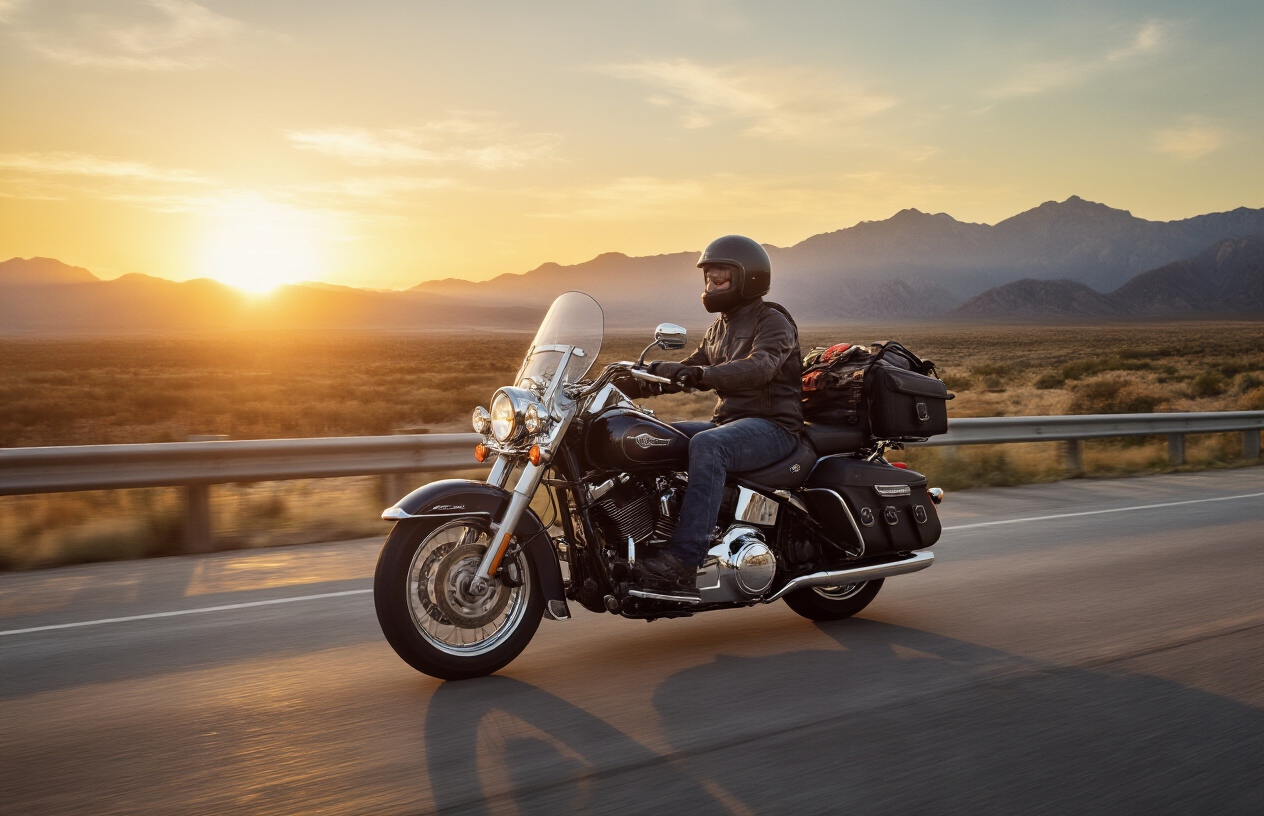
The Ultimate Guide to Touring Motorcycles in USA
Touring the diverse landscapes of America on two wheels requires the right motorcycle, proper preparation, and strategic planning. From selecting a touring bike with essential comfort features to understanding how to maintain your machine on the road, these elements are crucial for a successful cross-country adventure. Equally important is knowing how to optimize your motorcycle’s performance across various terrains and crafting an itinerary that showcases the best routes America has to offer.
Whether you’re a seasoned rider or planning your first long-distance journey, remember that the perfect touring experience combines the right equipment with thoughtful preparation. Take time to research your route, pack appropriate gear for changing conditions, and schedule regular maintenance checks. With the right motorcycle beneath you and proper planning, you’ll create unforgettable memories as you experience the freedom and beauty of touring America’s highways and byways.

